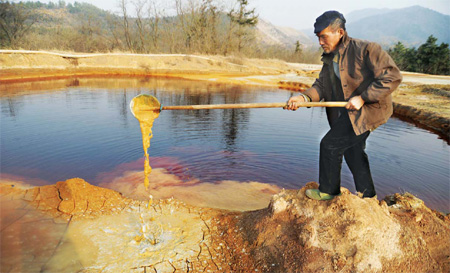Society
A hard rain is falling as acid erodes beauty
By Li Jing in Beijing and Peng Yining in Xiamen (China Daily)
Updated: 2011-01-12 07:16
 |
Large Medium Small |
Cities tackle problem. Li Jing in Beijing and Peng Yining in Xiamen report.
 |
|
A villager tries to scoop out polluted water from a pond in Xiaowang village in Anhui province on Dec 21, 2010. This pond has been heavily polluted by a nearby ore treatment plant, which produces raw materials for fertilizer. The contaminated water contains sulfur dioxide and flows directly to the fields, causing great danger to crops and various sources of drinking water. [Li Yuanbo / for China Daily] |
With its tranquil scenic beauty, Xiamen has long been regarded one of the best places to live or visit in China. The city, which lies in the southeastern part of Fujian province, boasts coastal vistas, unique architecture and a rich history dating back centuries.
Yet, this popular tourist hotspot is in danger of losing its sparkle, as acid rain continues to stain its colonial-era buildings, particularly on the famed islet of Gulangyu.
Official statistics show every drop of rain in Xiamen in the first half of 2010 was acidic, recording pH levels of less than 5.6 (neutral is 7).
"The acid rain is leaving buildings with yellowish signs of corrosion ... and is slowly turning the leafy island yellow," said Zhuang Mazhan, chief engineer at Xiamen's Environmental Monitoring Central Station. "It's making the city much less attractive."
Xiamen is not the only victim. Leshan Giant Buddha, which has stood in Southwest China for more than 1,000 years, has also been badly affected. Its nose is turning black, hair curls have fallen from its head and its reddish body is becoming a charred gray color.
At 71 meters high and 28 meters wide, the Buddhist statue in Sichuan province is the largest of its kind in the world. Since being carved out of a cliff during the Tang Dynasty (AD 618-907), the relic has survived floods and earthquakes, but it is now at great risk from a man-made threat.
Acid rain is a by-product of burning coal and fossil fuels. Combustion releases sulfur dioxide (SO2) and nitrogen oxides (both nitric oxide and nitrogen dioxide) into the air, which bond with water and oxygen molecules and then fall as sulfuric and nitric acid.
As the world's largest coal consumer, China is also the third largest acid rain region, after Europe and North America. A 2005 report found that 28 percent of the country's territory, mostly south of the Yangtze River, was affected by acid rain.
In 2005, Chinese factories spewed out 25.5 million tons of SO2, double the level regarded as "safe", according to the country's environmental authorities. The findings prompted the central government to adopt an aggressive target to rein in the rapid increase of SO2 emissions from unbridled industrial development. The aim was to reduce the discharge of the pollutant by 10 percent by the end of 2010.
Through phasing out inefficient thermal power-generating units and installing scrubbers (chemical filters fitted in chimneys) to remove pollutants, China achieved a 14-percent drop in SO2 emission between 2006 and 2010, from 2005 levels, said Zhou Shengxian, minister of environmental protection.
However, as China claimed victory in meeting its 10-percent sulfur reduction target, monitoring results showed acid rain is still battering many parts of the country, with increased frequency in some areas.
According to the latest annual quality report published by the Ministry of Environmental Protection, 258 cities and counties recorded acid rainfall in 2009. For 112 of them, at least one in every two precipitations was acidic.
In fact, the areas suffering from acid rain are actually expanding, with some already reporting increased acidity, an internal study commissioned by the ministry and led by Tsinghua University has discovered.
Monitoring stations in the Pan-Bohai Bay area in Northeast China, for example, have recorded the highest frequency and acidity of acid rain in 15 years, states the study report.
The coastal city of Dalian in Liaoning province, also a popular summer resort, reported an acid rain frequency of 51.6 percent in 2007.
Acid rainfall is also increasing along the west coast of the Taiwan Straits, around Chengdu and Chongqing in Southwest China and throughout the Pan-Beibu Gulf Economic Zone in the south. All these regions are expected to become the country's next growth engines thanks to booming heavy industries, such as petrochemicals, energy, metallurgy and equipment manufacturing, according to the Tsinghua-led study.